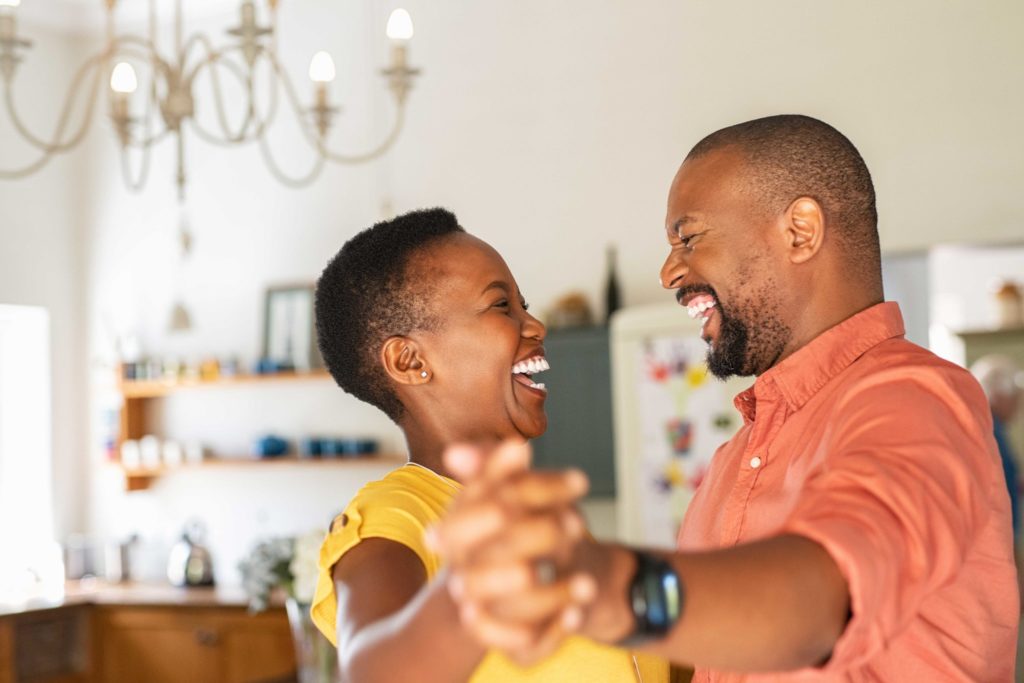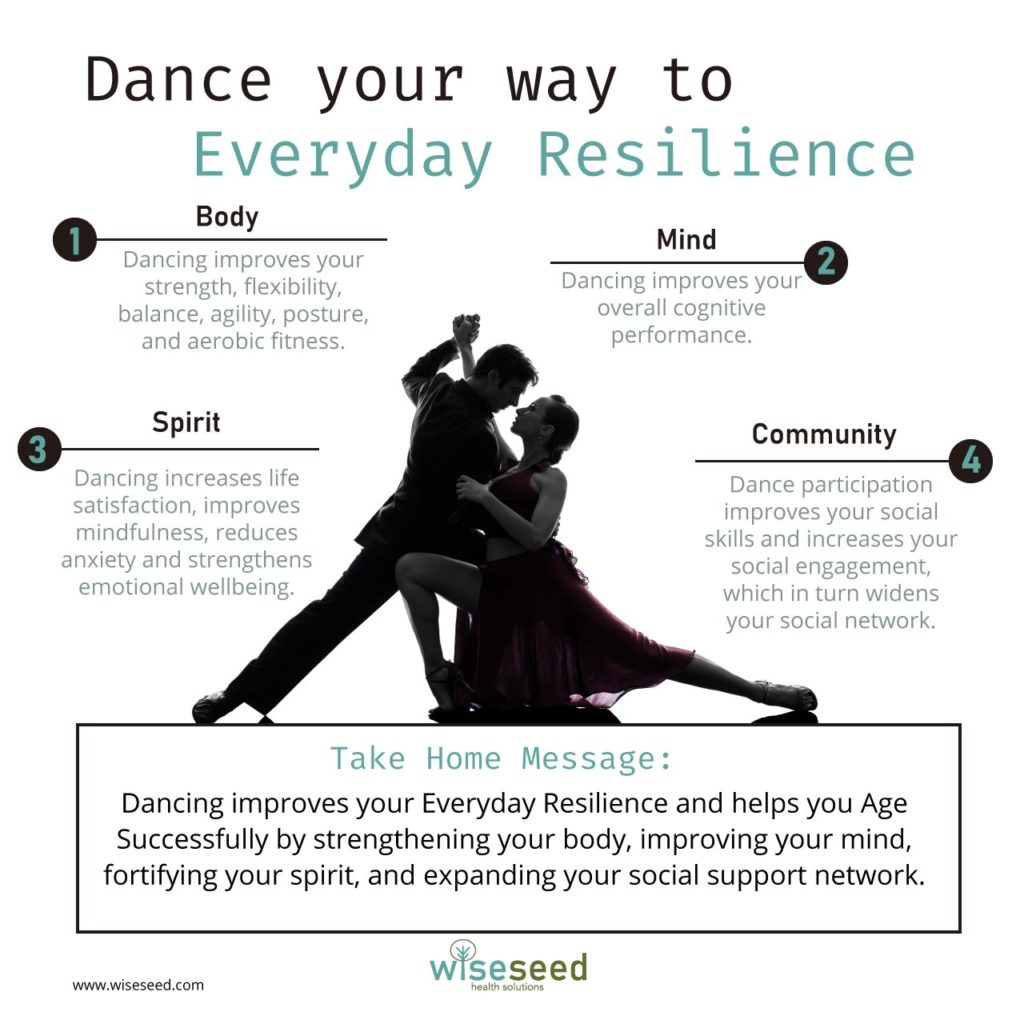Dance your way to Everyday Resilience

Dancing and Everyday Resilience
I recently discovered that dancing not only improves your Everyday Resilience, it also helps you Age Successfully.
Believe me, no one was more surprised than I to discover that dance is such a powerful lifestyle intervention!
Upon reflection I should have anticipated that dancing can have a huge positive impact on your everyday resilience. After all, dancing has engaged the human body, mind, and spirit – strengthened social ties and cohesion – and has served as a primary form of spiritual and emotional expression across human cultures for thousands of years.
However, this begs the question: Why is dancing so good for you?
Body
To begin with, dancing requires aerobic fitness, mobility, and high levels of co-ordination.
This combination of physical skills helps long-term dancers preserve their posture, balance and motor skills well into old age 1. Moreover, multiple studies have shown that dancing improve your endurance, strength and flexibility, balance and agility, motor skills, and posture 2,3.
Finally, the analysis of seven independent studies showed that dance interventions increase the cardiovascular fitness of older adults 4.
Because cardiovascular fitness reduces your chance of dying young, dancing helps you live longer. In addition, the health benefits of dancing will help you enjoy those extra years of life free from the burden of physical disability.
Mind
Of course, dancing is much more than mere aerobic exercise.
For starters, dancers learn ever-more-complex movement patterns. These movement patterns are performed in time to music, demanding rhythm and musical appreciation. Further, dancing with a partner requires anticipation, synchronization, spatial awareness, and (hopefully) some spontaneous creativity!
These are likely the reasons why dancing is a superior form of physical activity for improving and maintaining cognitive ability.
Not convinced? Then please consider the classic study by Buschke and Colleagues, which examined the link between leisure activity and the risk of dementia.
Here, the Author’s found that dancing was the only form of physical activity that reduced the risk of dementia 5! Notably, other physical pursuits such as walking, cycling, swimming playing team sports, and participating in group exercise had no such protective effect against cognitive decline 5.
Moreover, the idea that dance preserves cognitive function gained further support when dance interventions were shown to improve attention switching, cognitive flexibility, reaction time, and performance on cognitive tests 3.
Furthermore, the recent analysis of thirteen independent studies shows that dancing interventions have a significant positive effect on overall cognition 6.
Thus, dancing improves your cognitive function and protects you from dementia as you age.
Spirit
In addition to strengthening your body and fortify your mind, dancing also provides spiritual support.
For example, dancing has been shown to increase life satisfaction, improve mindfulness, reduce anxiety, and strengthen emotional wellbeing 3.
Furthermore, women who participate in belly dancing experience improved body image and self-acceptance 7. This is particularly true for older women, who report that belly dancing significantly improves their emotional and psychological self-image 7.
Community
Your social network is arguably your most important asset for improving your resilience and aging well. The good news is that dance, being an intrinsically social activity, has a large and positive effect on your social support network.
Dance participation improves your social skills and increases your engagement with social activities, which widens your social network 3. This in turn improves your everyday resilience and increases your chance of aging successfully.
Take Home Message
Hopefully, if you’ve read this far, you’re at least intrigued by the idea that dancing can dramatically improve your life.
To briefly re-iterate, independent studies have shown that dancing can improve your body, strengthen your mind, nurture your spirit, and expand your social network.
And let’s not forget that dancing is also fun!
For these reasons, I argue that dancing should be near the top of your to-do list in 2021 and beyond.
Please click on the link below to download your free PDF.

References and Further Reading
1 Kattenstroth, J. C., Kolankowska, I., Kalisch, T. & Dinse, H. R. Superior sensory, motor, and cognitive performance in elderly individuals with multi-year dancing activities. Front Aging Neurosci 2, doi:10.3389/fnagi.2010.00031 (2010).
2 Keogh, J. W., Kilding, A., Pidgeon, P., Ashley, L. & Gillis, D. Physical benefits of dancing for healthy older adults: a review. J Aging Phys Act 17, 479-500, doi:10.1123/japa.17.4.479 (2009).
3 Sheppard, A. & Broughton, M. C. Promoting wellbeing and health through active participation in music and dance: a systematic review. Int J Qual Stud Health Well-being 15, 1732526, doi:10.1080/17482631.2020.1732526 (2020).
4 Rodrigues-Krause, J., Farinha, J. B., Krause, M. & Reischak-Oliveira, Á. Effects of dance interventions on cardiovascular risk with ageing: systematic review and meta-analysis. Complementary Therapies in Medicine 29, 16-28 (2016).
5 Verghese, J. et al. Leisure Activities and the Risk of Dementia in the Elderly. N Engl J Med 348, 2508-2516, doi:10.1056/NEJMoa022252 (2003).
6 Meng, X. et al. Effects of dance intervention on global cognition, executive function and memory of older adults: a meta-analysis and systematic review. Aging Clinical and Experimental Research 32, 7-19 (2020).
7 Moe, A. M. Sequins, sass, and sisterhood: an exploration of older Women’s belly dancing. Journal of Women & Aging 26, 39-65 (2014).
Disclaimer
The material displayed on this website is provided without any guarantees, conditions or warranties as to its accuracy.
Information written and expressed on this website is for education purposes and interest only. It is not intended to replace advice from your medical or healthcare professional.
You are encouraged to make your own health care choices based on your own research and in conjunction with your qualified practitioner.
The information provided on this website is not intended to provide a diagnosis, treatment or cure for any diseases. You should seek medical attention before undertaking any diet, exercise, other health program or other procedure described on this website.
To the fullest extent permitted by law we hereby expressly exclude all warranties and other terms which might otherwise be implied by statute, common law or the law of equity and must not be liable for any damages whatsoever, including but without limitation to any direct, indirect, special, consequential, punitive or incidental damages, or damages for loss of use, profits, data or other intangibles, damage to goodwill or reputation, injury or death, or the cost of procurement of substitute goods and services, arising out of or related to the use, inability to use, performance or failures of this website or any linked sites and any materials or information posted on those sites, irrespective of whether such damages were foreseeable or arise in contract, tort, equity, restitution, by statute, at common law or otherwise.

Ten Minutes is All You Need
Research has shown that ten minutes of moderate-to-vigorous exercise performed each day is enough to significantly reduce your risk of early death.

Ten Minutes is All You Need
Research has shown that ten minutes of moderate-to-vigorous exercise performed each day is enough to significantly reduce your risk of early death.


